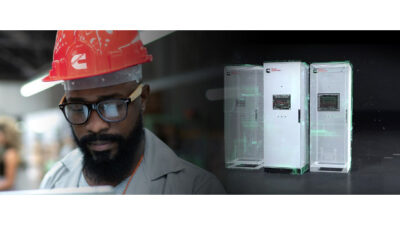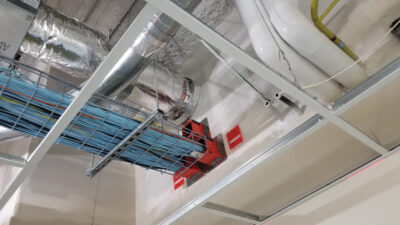Does your mission critical facility need backup power? Learn to specify by reading this Q&A from a recent NFPA 110 webcast.

NFPA 110 insights
- The 2022 edition of NFPA 110: Standard for Emergency and Standby Power Systems covers performance requirements for emergency and standby power systems providing an alternate source of electrical power in buildings and facilities in the event that the normal electrical power source fails.
- Understanding the various aspects of power systems and their specifications are important to electrical engineers.
Mission critical facilities nearly always need some sort of backup power systems. Systems include power sources, transfer equipment, controls, supervisory equipment and accessory equipment needed to supply electrical power to the selected circuits.
During the critical power webcast, NFPA 110: Standard for Emergency and Standby Power Systems, the presenters were asked several questions, several of which are answered here.
Expert presenters:
- Richard Vedvik, PE, senior electrical engineer and acoustics engineer, IMEG Corp., Rock Island, Illinois.
- Tom Divine, PE, senior electrical engineer, Johnston, LLC, Houston.
As engineers, how do we handle the fact that our generator sizing calculations provides a minimum generator size that is usually a lot larger than the loads seen in the field by the owner: 25%-50% loaded max on a good day. Sometimes we can’t get the 30% min generator load from the system when yearly tested.
Richard Vedvik: This may be the result of the calculations making faulty assumptions about what happens at each step. The sizing software may be assuming that all of the load assigned to that step occurs at the moment of transfer and not over a span of time as system “soft start” and have staggered startup.
What is the most critical item to coordinate power transfer?
Richard Vedvik: Depends on the project requirements.
Is the requirement for a two-hour rated room in an indoor installation to protect the engine-generator or to protect the rest of the building from it?
Richard Vedvik: While I cannot speak to the intent of the committee who wrote it, when we look at other areas of code that require two-hour protection it is usually to protect the item from the building and not the other way around. For example, the requirements under NEC Article 700.10(D) for fire protection are not to protect the building from the cables.
Are there additional required clearances for indoor gas generator set besides NEC 110.26? Any differences if it is emergency or standby?
Richard Vedvik: Manufacturer clearances for maintenance and accessibility would apply. Additionally, engineers should plan for unit replacement and servicing, allowing for adequate space for future work.
Does the code prohibit putting all emergency loads on Level 1 if the generator has the capacity to power all systems?
Richard Vedvik: By definition, “emergency” loads as described in NEC Article 700 are all first priority. Note that “Level 1” as defined by NFPA 110 is a category based on the types of loads served. The reason that NEC Article 517 and NEC Article 700, 701 and 702 have different loads assigned to each is to protect more critical loads from less critical loads and is independent of generator loading.

Can a panelboard or distribution panel be in the same room as the ATS even though the loads they serve or located outside of the room?”
Richard Vedvik: Code does not prohibit distribution panelboards from occupying the same room as transfer switches. Loads served by panelboards are usually located outside of the electrical room. NFPA 100 Ch. 7.2.3 identifies separation of normal service equipment (i.e., NEC Article 230) from being in the same room as Level 1 EPSS if the normal service equipment is >150V to ground and >= 1000A.
Is shunt trip of nonemergency loads acceptable in lieu of separate transfer switches?
Richard Vedvik: Operable circuit breakers can be an acceptable means of executing load shed.
Do emergency feeders still need fire protection if they are outside of the occupancy (such as feeders underground or otherwise totally outside of the structure)?
Richard Vedvik: This interpretation requires AHJ approval. One may look at what is constituted as “outside” by looking at NEC Article 230, but the definitions within Article 700.10(D) do not explicitly reference Article 230.
Are telecom applications generally designated as level 1 or level 2?
Richard Vedvik: That depends on what the telecom systems is being used for and what other Code sections define those systems as.
Are elevators in high-rise construction considered legally required standby?
Richard Vedvik: Elevators used for fire rescue are treated differently and have unique requirements from elevators that are not designated as fire rescue.
Is there battery backup lighting requirements for exterior Level 1 generators?
Tom Divine: NFPA 110, 2022 Edition, 7.3.1 requires battery-powered emergency lighting is for Level 1 or Level 2 EPS equipment locations, other than units housed in enclosures without walk-in access. Walk-in access appears to refer to enclosures that provide room for personnel between the generator and the inside wall of the enclosure. So, for an outdoor enclosure in which he generator is accessible from the outside through openings in the enclosure walls, battery-powered emergency lighting is not required.
Is a temporary source of power required in all applications where we have generators?
Tom Divine: NEC 700.3(F) requires permanent switching means for the ready connection of a temporary alternate source for an emergency system that relies on a single generator. For parallel systems, in which the emergency load can be supported by one of a number of generators, a temporary generator port is not required.
Is there a requirement for the amount of fuel that must be kept in a day tank for diesel generators in a hospital setting?
Richard Vedvik: The day tank acts as a local reservoir for supply and return fuel for a diesel generator set and the size would be as recommended by the generator supplier for reliable operation. There is no Code minimum that I am aware of but there is a maximum of 660 gallons total in NFPA 30.
Does a central battery inverter unit used for egress lighting installed in a separate room form the normal power panels?
Richard Vedvik: If you’re asking if a central inverter needs to be installed in a separate room from the normal power panels, I am not aware of such a requirement.
If the existing building only has one ATS since the building was built 30 years ago, when replacing the existing generator, is it required by code that we separate the life safety loads from other loads?
Richard Vedvik: The AHJ will determine the extents of correction of what we call “comingling” of the EPSS. The challenge that I typically encounter is that when doing remodels within a building, with a system as you describe, I do not feel that I can use the existing EPSS since the required branch separation does not exist.
Are control systems, in lieu of multiple transfer switches, permitted when step-loading standby loads?
Richard Vedvik: Using a modern building automation system to control mechanical systems can be a useful tool to mitigate generator loading or to carefully add additional systems to an EPS without overloading. The approach you describe, assuming Article 517 Equipment Branch or Article 702 Optional Standby Branch, would still require AHJ approval and acceptance of the EPS manufacturer.
Does code require the Emergency, Legally Required and Standby breakers to be separated at the generator alternator? Can they be mounted in a common enclosure/alternator enclosure?
Richard Vedvik: The NEC Handbook has graphics that show ways to achieve separation requirements and each identifies separate enclosures. In a generator enclosure, it appears that grouping separately enclosed OCPD would match one of the supplied diagrams.
What are the chances of freezing temps in the generator room with the generator running? Enough to freeze a sprinkler system?
Richard Vedvik: It is not uncommon for northern climates to use a dry-pipe sprinkler system in generator rooms for freeze protection.
What is the requirement for the air intake sound attenuators?
Richard Vedvik: There is no written requirement for the presence of or type of inlet sound attenuator because noise control requirements are defined by other Codes and AHJs.
Are CFD models or wind studies required to show generator exhaust will not affect building ventilation air inlets?
Richard Vedvik: This depends on the project location. I have seen these calculations performed in the State of Iowa.
What experience do you have with AHJ allowing natural gas generators for L1? In Massachusetts, I have not had success.
Richard Vedvik: In my experience, the use of natural gas has been limited to Level 2 systems.
What is the difference between a standby generator and an emergency generator?
Richard Vedvik: A standby generator is different from a prime-rated generator in terms of actual output rating by the manufacturer. When the term “emergency generator” is used, it is usually associated with a standby generator.
Is temporary source of power required in all applications where we have generators? NEC 700.3(F)
Richard Vedvik: Where NEC Article 700 applies and where “the emergency system relies on a single alternate source of power.”
Are the numerous requirements best handled in a presentation type meeting with vendors, AHJ and client with engineers and architects?
Richard Vedvik: In my experience, it can be difficult to coordinate all associated parties at the same time. Some project may be able to achieve this, while others may require separate meetings with the AHJ and vendors with a summary meeting with the client, all led by the engineer.
Other than testing, how can you be sure that the generator and enclosure selected are within limits for noise requirements?
Richard Vedvik: An acoustical consultant can perform calculations to determine the project requirements for compliance.
For the remote annunciation, could we use the building EPMS instead of the generator manufacturer supplied annunciator?
Richard Vedvik: Note that there are several types of annunciation listed in NFPA 110 Chapter 5.
Does NEC 700, 701 and 702 systems each require a separate ATS?
Richard Vedvik: Yes. NEC Article 517.31 does allow for one ATS for loads less than 150kVA, when applicable.
Tom Divine: NEC 700.5(D) prohibits a transfer switch that serves emergency loads from serving any other kind of load. That prohibition doesn’t appear in Articles 701 or 702, so it would appear that serving legally-required standby and optional loads from the same transfer switch is acceptable, so long as the system capacity is large enough to serve all the loads or selective load-shed is provided to protect higher-priority loads. The Articles don’t explicitly state that the same transfer switch can supply both 701 and 702 loads, though and opinions of AHJs and engineers vary on this issue. It’s wisest to get the AHJ’s position on this issue during design.
Are there specific requirements for power to support remote radiators?
Richard Vedvik: Yes, and I have seen remote radiators powered directly from the generator output and not through a transfer switch, to prevent thermal shutdown due to a delay in cooling operation.
For a new system without existing ATSs, when would you specify a 3-pole or 4-pole ATS? Are there advantages of one over the other?
Richard Vedvik: When given the option, I will always use 4-pole ATS and have the EPS as separately-derived. Bonding neutrals between the two systems creates circulating currents that can negatively effect service ground fault detection.
When using multiple generators, how do we ensure that all of the generators stay in phase and frequency?
Richard Vedvik: That is the job of the paralleling engine controller and that capability needs to be part of the design.
What is the difference between a belly tank and a day tank?
Richard Vedvik: A “belly tank” is usually just a unit-mounted “day tank.”
Do circuit breakers have to be in separate switchboard sections when supplying life safety, critical and equipment branches in health care?
Richard Vedvik: No. 2020 NEC Article 517.31(A) states that division of branches shall occur at the transfer switch and this section references 2018 NFPA 99 6.7.2.3.1 in which the commentary expressly states that the OCPD separation identified in NEC Article 700 is not required upstream of transfer switches because no branch exists yet at the upstream OCPD.
If you have a life safety generator and a portable engine connection box with transfer circuit breakers, should the fire pump and fire alarm taps be made ahead of life safety generator main or after?
Richard Vedvik: If the permanent generator provides an alternate source to the fire pump, the temporary generator should also support that alternate source.
If you have ATSs in multiple locations in a building would the start circuit that is installed to the generator need to be two-hour rated?
Richard Vedvik: When start conductors are required to be two-hour rated that applies regardless of physical location of the ATS.
Working on a generator replacement for a multibuilding campus-style complex with one utility service to entire campus on an unreliable utility source. The generators are optional standby and backup entire service to campus. A new building was added to the campus distribution with a fire pump (connected ahead of building disconnect). Does this change the classification of the generators to legally-required standby?
Richard Vedvik: “Legally required” is a transfer switch branch designation, not an EPS designation. An AHJ needs to assign the Level to the EPS and the alternate source for the EPS, as defined by NEC Article 695, needs to be taken into consideration.
The move of communication systems in a building are moving to digital systems powered by PoE. That includes emergency phones, area of rescue/refuge, elevators PoE lighting and more. Is the generator power then legally required or standby power for Tech Rooms?
Richard Vedvik: I have seen some AHJ require Life Safety branch power for supervised paging systems used as emergency communication systems in health care. Engineers and designers need to pay careful attention to the types of loads, their usage and associated Codes, when choosing which branch to use.
When it comes to Data Centers and Communications Nodes, what Levels and Types would Levels would you recommend?
Richard Vedvik: It is not as much a recommendation as a requirement by various Codes and Standards. If lives can be lost upon the failure of the system, then Level 1 is usually enforced.
Is it permissible to back up the whole building with one generator, two transfer switches one for the building’s emergency loads and one for the fire pump, assuming that everything such that the emergency lighting, elevators, mechanical equipment etc. feeders are all required two hours? Or are we mandated to separate the 10s loads from the 60s loads?
Richard Vedvik: NEC Article 700, 701 and 702 list acceptable load types in each section and combining them is usually seen as a violation. The commentary surrounding the reason for separate branches will commonly explain that protection emergency branch loads from optional branch loads is the reason for the separation.
Is the equipment branch in NEC 517 a legally required standby system covered in NEC 701?
Richard Vedvik: No. They are different branches with different requirements.
What is the stance on NEC 700.10(D)(4) Generator Control Wiring? Is that required for all facilities except health care? Who enforces that, AHJ?
Richard Vedvik: Note that NEC Article 517 and NFPA 99 reference NEC Article 700 for the Life Safety Branch, with some exceptions.
Do the Power conductors Need to be two-hour fire ratine for emergency generator?
Richard Vedvik: Refer to NEC Article 700.10(D) or NEC Article 695 or NEC Article 517 for specific fire-rating requirements of conductors.
Are unoccupied pump stations subject to NFPA 110?
Richard Vedvik: If the pump station does not meet the classification of a Level 1 or Level 2 system, compliance is usually not enforced, but NFPA 110 is used as a design guide.
Would you mind sharing the name of your cat?
Richard Vedvik: Scout.



